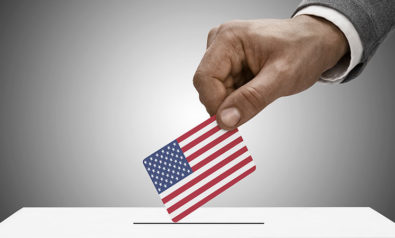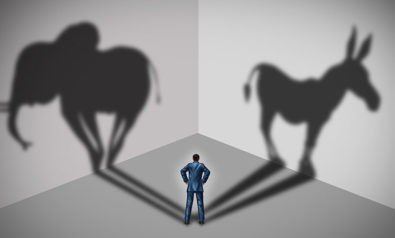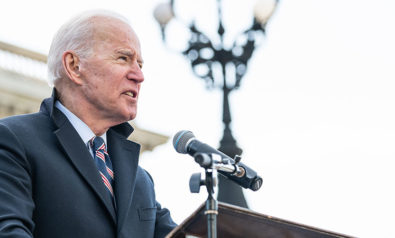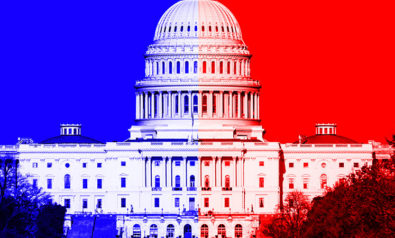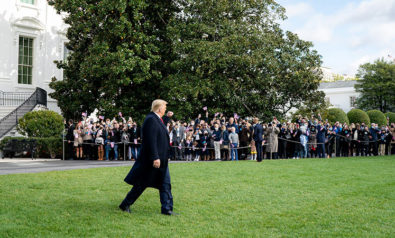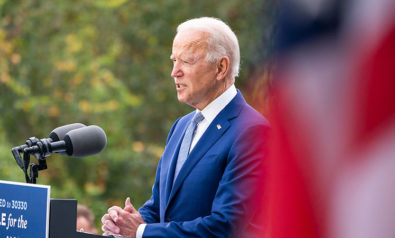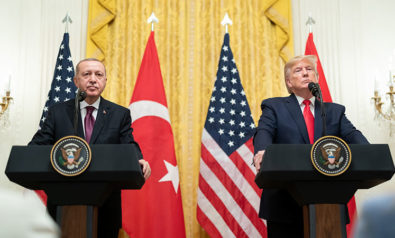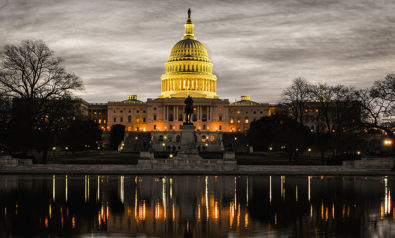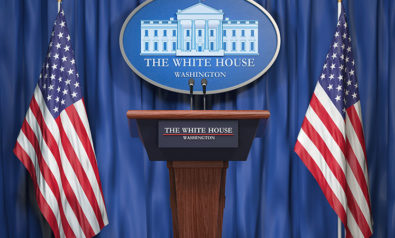Every year, the movers and shakers of our times come together for a few days in Davos, a swanky resort of literary fame in the Swiss Alps thanks to Thomas Mann, who made it the setting of his magnum opus, “The Magic Mountain.” Today, the economic, political and academic high-flyers no longer come to Davos to be cured of tuberculosis but to contemplate the state of the world. In recent years, the results have been increasingly somber, reflecting a new realism, not to say pessimism, that one might not have expected from such an illustrious crowd. Last year, the reunion was dominated by the threat posed by the eruption of populism.
Michael Froman, the vice president of Mastercard, set the tone with his warning that “one thing is clear: nationalism, populism, nativism, and protectionism are on the rise. Economic insecurities, as well as a growing sense of lost sovereignty, have contributed to an unprecedented degree of political polarization, and not just in the US.”
360˚ Context: The 2020 US Election Explained
The reference to the United States is hardly surprising. For the past several years, anyone writing on populism and its various aspects has invariably invoked two major events: Brexit and the election of Donald Trump. Both have been framed as part of a larger populist revolt, which is characterized as one of the most significant and distinctive, if not outright defining, political features of today’s world. But is it really that clear-cut, that obvious?
It largely depends on how populism is defined. Is it merely an expression of widespread disaffection with a political system that appears to have largely failed to take seriously and address the grievances of the “ordinary people”? Or is it something entirely more serious, something that poses a fundamental challenge, if not a threat to liberal democracy?
It Can’t Happen Here
As is so often the case, there is ample support for both interpretations. This might explain the passionate, diametrically opposed sentiments Donald Trump has and continues to evoke. Despite everything — his shallowness coupled with an egotism that borders on the pathological, his dishonesty and myriads of lies, his vulgarity, callousness and utter lack of empathy, his obvious ignorance and glaring incompetence — a substantial part of the American electorate will support him, no matter what.
At the same time, because of what Trump embodies, stands for and projects, a substantial part of the American electorate has nothing but contempt for a president who once claimed that he could shoot somebody in the middle of Manhattan and still maintain the support of his voters. Unfortunately, he might have been right.
Statements like that led a number of commentators ahead of the 2016 election to express fears that a Trump presidency might descend into fascism. Some of them evoked Lewis Sinclair’s 1935 novel “It Can’t Happen Here,” pointing out the eerie resemblance between Sinclair’s Berzelius “Buzz” Windrip and Donald Trump. Several years into his presidency, the debate of whether or not Trump is a fascist is still in full swing.
The answer is fairly obvious, at least for those who have spent some time studying fascist regimes, such as Benito Mussolini’s totalitarian state. This, in fact, is one of the central tenets of fascism — the glorification of the strong state. As Mussolini once put it, “Everything in the state, nothing outside the state, nothing against the state!” What this phrase means, at least in theory, is nothing less than the complete subordination of the individual to the exigencies of the state and its supreme leader. Reality, of course, looked a bit different, as Federico Fellini has so brilliantly shown.
It is for this reason alone that the fascism charge against Trump makes little sense, given America’s long tradition of, and abiding allegiance to, individualism. It is the rampant individualism that permeates American social and economic life, which, for instance, has been identified as a major reason for the widespread refusal in recent weeks to wear masks. Under the circumstances, it is probably best to abandon the fascism charge altogether, if only because comparing Trump to the likes of Mussolini and particularly Hitler can only but contribute to the trivialization of fascism and Nazism, responsible for mass murder and horrendous suffering on a massive scale.
If Not Fascist, Then What?
If not a fascist, what then is Trump? Over the course of his presidency, it has become increasingly obvious that Donald Trump represents the epitome of a radical right-wing populist — and of the worst kind. Radical right-wing populism is a blend of populism and nativism, which promotes a fundamental social and political transformation of the existing liberal system. This is along the lines of Victor Orban’s model of “illiberal democracy” — the endpoint of a slow process of eroding and ultimately asphyxiating both the ideational and institutional foundations of liberal representative democracy. In the past, the populist model of illiberal democracy was largely confined to Latin American regimes, starting with Juan Perón in Argentina and ending with Hugo Chavez in Venezuela and Evo Morales in Bolivia.
In the United States, the most outstanding example of this kind of populism was Huey Long, first the governor of, then the senator for Louisiana in the late 1920s and early 1930s. And, in fact, commentators have drawn parallels between Long, “with his loud mouth and boorish ways,” as a contemporary characterized him, and Trump. Both men “presented themselves to the electorate as insurgents, outsiders seeking to disrupt the established order and tackle vested interests, promising widespread economic and political reform.” Both men, once in office, displayed authoritarian dispositions and established and consolidated a system of cronyism, if not outright corruption, fundamentally at odds with the tenets of America’s model of liberal democracy.
Here, however, the resemblance ends. Unlike Trump, Long was genuinely concerned about the plight of the poor and, particularly as senator, pushed for a progressive agenda centering around redistributive policies. In fact, his most memorable message, as Adrian Mercer points out, “aimed at the state’s poor, dispossessed, and marginalised, was encapsulated in the “Share our Wealth” programme which offered voters a promised land where, in his famous phrase, “every man a king.”
According to the prominent economist Barry Eichengreen, Long proposed capping annual incomes at $1 million and inheritances at $5.1 million. The resulting revenues were supposed to go into a basic income of $2,500, provide pensions to the elderly, free health care to veterans and free education to students attending college or vocational training. And unlike Trump, Huey Long never had the chance to run for president. He was murdered in 1935, his assassination triggered by his maneuvering in Louisiana’s legislature to rid himself of one of his political opponents.
Populists justify this kind of shenanigans (getting rid of opponents via legislative means) as expressions of the “will of the people.” The people’s will is deemed confirmed via numerous elections and popular referenda and summed up, as it were, by the populist leader who incarnates the people — “El pueblo soy yo,” as the title of Enrique Krauze’s book on populism puts it. Since the populist leader is nothing but the expression of the will of the people — what Ernesto Laclau has called an “empty signifier” onto whom the people can project their anxieties, fears, fury, resentments and, yes, aspirations — there is no need for checks and balances and competitive pluralism. The result is a state “in which the political power relativizes the rule of law, democracy and human rights in politically sensitive cases; constitutionalizes populist nationalism; and takes advantage of identity politics, new patrimonialism, clientelism, and state-controlled corruption.”
In order to bring this about, populists have employed what Stephen Gardbaum has referred to as “revolutionary constitutionalism.” This entails “using the constitution-making (and amendment) process as a tool of ordinary rather than higher politics to entrench an existing or newly empowered government’s position through measures that concentrate its power and render successful electoral opposition more difficult.” This is what happened, in one form or another, in Hungary, Venezuela, Bolivia and Ecuador under populist regimes.
“Own People”
Illiberal democracy is only one side of the radical right-wing populist coin. The other, and significantly more important one — particularly in the case of political parties in competitive representative democracies such as exist in Western Europe that have little chance to gain an absolute majority — is nativism. Nativist doctrine maintains that the interests of the “native-born” should have absolute priority over those new to the national community. The “own people” should always come first: citizens before non-citizens, the native-born before foreigners, the own nation before the rest of the world. Popular slogans such as National Rally’s “La France aux français,” (“France for the French”), “Les français d’abord” (“The French First”), or Vlaams Blok’s “Eigen Volk Eerst” (“Own People First”) attest to the centrality of nativism in the radical populist right’s ideational repertoire.
Politically, nativists stand for protecting a country’s job market and welfare benefits against “outgroup” competitors. At the same time, they promote a wide array of measures designed to defend, maintain and revive the cherished heritage of the autochthonous population’s culture, customs and values. As far as the government is concerned, nativist doctrine demands that it demonstrate a “reasonable partiality towards compatriots by protecting and advancing the socioeconomic and cultural welfare of its own citizens, more often than not defined in ethnic terms.”
Radical right-wing populism is hardly new to American politics. In fact, nativism originated in the United States in the first half of the 19th century, with the arrival of waves of immigrants from Europe, the vast majority of them Catholics from Ireland and the southern parts of Germany. In response, Protestants organized secret societies and associations set on countering what they considered the “deadly threat” to the republic posed by an alien force they deemed intent on subverting the country’s institutions and ultimately subordinating America to the pope.
Over time, the various anti-Catholic organizations merged into a political party, popularly known as the Know Nothings, which combined anti-elite populism with a strong dose of nativism. For a few years in antebellum America, the Know Nothings posed a significant threat to the established political system before falling apart over a new contentious issue — abolitionism. Ironically enough, many Know Nothings joined Abraham Lincoln’s Republican Party, bringing with them a legacy of anti-Catholicism.
Perhaps not surprisingly, the Republican Party under Donald Trump has been compared to the Know Nothings, given its “loathing for immigrants.” This comparison is both fair and unfair: fair because the Know Nothings stoked anxieties and fears of a Catholic takeover of the United States, which was ludicrous, to say the least; unfair because unlike today’s Trump-subservient minions in the Republican Party, the Know Nothings never outright opposed immigration, not even from Catholic countries, and never advocated closing America’s shores or building a wall. What they demanded instead was extending the period of naturalization to 21 years, equal to the period it took for a “native-born” to become a citizen with full citizen rights.
Greatest Suction Pump in the World
In the wake of the COVID-19 pandemic, nativist sentiments have received a significant boost. Surveys suggest a substantial increase in public support for economic protectionism, particularly with respect to critical and strategically important sectors such as health and food. At the same time, calls for regaining national sovereignty, particularly as it regards national borders, and for shoring up a sense of national identity have gained increasing support, not only among the public, but also among the political establishment.
Last but not least, the pandemic has provided new justifications for demands to further reduce access to social benefits to the “undeserving” — primarily migrants from non-Western countries — in order to further reduce the welfare state’s pull effect which, as nativists charge, is a major reason why migrants and “bogus refugees” seek to enter Western Europe.
The ultimate objective is to completely shut down the “suction pumps” — “pompes aspirantes,” as the National Rally likes to put it — such as generous welfare benefits that are held to be the main reason migrants are attracted to Western Europe. Nativists justify their position by claiming that the influx of migrants and the resulting growing ethnocultural diversity threaten to weaken social solidarity and, in the processes, undermine support for the welfare state — what in the welfare state literature is known as the progressive dilemma. It stands to reason that in the wake of COVID-19, “welfare chauvinist” sentiments have grown, even if the absence of reliable survey data prevents a conclusive statement.
Given these trends and developments, it is probably safe to say that with COVID-19, the “opportunity structure” for radical right-wing populist mobilization has considerably improved. Whether or not this will actually benefit the radical populist right at the polls depends to a large extent on their ability to exploit the political opportunities the pandemic has opened up. The November election is likely to provide the first tentative answers.
During his tenure as president of the United States, Donald Trump has provided ample evidence that he is the paragon of a radical right-wing populist leader well versed in eliciting some of the worst impulses and affects in human nature. As Frank Bruni has recently put it in The New York Times, “Trump has shown America its resentments. He has modeled its rage.” This explains to a large extent why his appeal among substantial parts of the American electorate remains strong until today. Trump’s amazing staying power, despite his glaring incompetence and lack of positive human emotions, has largely been based on his uncanny ability to sense the grievances and resentments of his various constituencies and turn them into a simplistic narrative of victimization, with himself as the prime victim.
Populism is a particular style of politics that to a large extent plays on affect and emotions. The gamut is wide, ranging from anxiety, fear, anger and resentment to disdain and contempt, to name but the most important. One, however, is of particular importance in contemporary radical right-wing populist discourse: nostalgia. Nostalgia is that yearning for a happier past “when the world was still in order,” as the Germans like to say. In the United States, these were the days of “Leave it to Beaver” and “Happy Days,” the world evoked in “American Graffiti” and “Diner.” These were the days when a factory job could still guarantee a middle-class life, complete with a house, two cars and two-and-a-half children.
These were the days when men were still men, women knew their place in society, gays did not dare to come out of the closet, and marriage was limited to a union between a man and a woman. These were the days when the United States was the dominant world power, economically, militarily, even culturally, with Western European audiences were glued to “Dallas” and “Charlie’s Angels.” These were the days when Americans had reason to claim that theirs was “the greatest country in the world.”
Today, only those Americans who have never set foot out of their neck of the woods, who still believe that Ontario is part of the United States, would subscribe to this notion. For the rest, the realization has sunk in that America is no longer what its cheerleaders on Fox News claim it to be, that the nation is not only coming apart at the seams but increasingly falling behind the rest of advanced capitalist countries and thus no longer attractive as a destination.
Take, for instance, the case of Norway. In 2018, Trump made it known to the world that he wished for more Norwegians to come and settle in the US rather than all those migrants from “shithole countries” such as Haiti or the African nations. As it turns out, Norwegians — hundreds of thousands of whom migrated to the United States in the 19th century — waved off Trump’s invitation. In 2016, a mere 500 Norwegians moved to the US, 10% less than in the previous year.
The End of the American Dream
For the past several decades, a large number of Americans have deluded themselves in believing that theirs is indeed the greatest country on earth. Even Trump’s famous slogan, “Make America Great Again,” apparently failed to alert them to the fact that the tag line might indicate that America was no longer great. And if it actually did, they could always claim that if America was no longer what it used to be, it was all Obama’s fault or the result of an evil plot by the left. Reality, however, tends to be tenacious and rather impervious to spin. Ironically enough, it is that reality which to a large extent explains Trump’s continued appeal.
In fact, numerous studies over the past few years have shown that what permeates American society is a profound malaise, which to a large extent has preceded the current pandemic. As a Pew study from early 2019 put it, “Looking to the Future, Public Sees an America in Decline on Many Fronts.” At the same time, the Trump presidency, despite all of its bluster and hype, has done nothing to reverse these sentiments. In September, less than 30% of likely voters thought the country was going in the right direction — virtually unchanged from the last year of Barack Obama’s presidency. And yet, Trump has remained politically competitive and might still win the November election. It would be intellectually dishonest to claim that there is one indisputable explanation for why this is the case. The fact is that there are numerous plausible explanations, all of which throw light on different parts of reality.
This brings us back to Ernesto Laclau’s theory on populism, particularly his notion of the empty signifier briefly mentioned earlier on. Laclau’s take on populism is to start with the most basic unit of analysis, disparate grievances and demands expressed by ordinary people. If the political establishment fails to meet them, these unsatisfied grievances and demands, particularly if they establish a common denominator — “they could care less about us” — create what Laclau calls a “frontier,” a gap between those below and those on top, which is the perfect basis for populist mobilization.
In order to understand these dynamics, it is necessary to proceed in two steps. The first step regards the socioeconomic and socio-structural conditions and developments that have given rise to grievances and demands. The second step regards the nature of these grievances and demands, and how they play themselves out politically. One word of caution, however: Not all grievances and demands are the result of recent developments. Some of them have been simmering for a long time, until they found an outlet in the presidency of Donald Trump.
One of the most widely cited explanations of the outcome of the 2016 election is Diana Mutz’s study from 2018. Mutz advances two arguments. On the basis of empirical evidence, she postulates that Trump’s victory was informed by both a “perceived status threat by high-status groups” — white Americans of European stock — and “American insecurity about whether the United States is still the dominant global economic superpower.”
Status Loss
This is hardly the first time that there is a strong sense of decline in the United States. Already in the late 1980s, there were similar concerns, only that time with respect to Japan and Western Europe. Task forces were set up at prominent institutions like MIT, commissioned to examine what had gone wrong and come up with ideas of how America could regain its “productive edge.” With the boom of the 1990s, fueled by the dotcom bubble, the concern with decline quickly dissolved in thin air.
Today, the situation is fundamentally different. With the rapid ascent of China, the United States is faced with a substantially more serious challenge. As Joseph Nye wrote a year ago in the Financial Times, “Many in Washington, both Republicans and Democrats, fear that the rise of China will spell the end of the American era. This exaggerated fear itself can become a cause of conflict.” Nye was skeptical about China’s potential to pose a serious threat to the United States anytime soon. Others less so, above all Donald Trump. His increasing belligerence toward China reflected not only personal acrimony but a broader irritation with the fact that “an economic system different from the U.S. has succeeded so remarkably.”
There are, of course, a number of quite real reasons for American anxieties and irritation when it comes to China. For one, China has become America’s main creditor, holding hundreds of billions of US debt. Secondly, there is a sense that China is largely responsible for American deindustrialization. To be sure, this is largely bogus. Deindustrialization has a number of causes, most prominently perhaps the pervasive influence of financialization. But it is far easier to blame China than confront domestic failures and shortcomings.
Deindustrialization is, of course, one of the major drivers of the second development identified by Mutz, the perceived loss of status by hitherto relatively high-status groups. Much has recently been written about the importance of status loss for explaining the success of radical right-wing populism. The mechanism, as Sarah Engler and David Weisstanner describe, is fairly straightforward: “The relative deterioration in material conditions … translates into a lower subjective social status of vulnerable groups who then turn towards the radical right.” In the past, loss of status resulting from socioeconomic modernization affected primarily routine blue-collar workers, losing out to competition from cheap labor in developing countries. Today, the range of potential victims of globalization is much greater, reaching all the way into professional groups. This is to a large extent due to the rapid pace of innovation in emerging technologies, such as robotics, AI, 5G and nanotechnology, to name but a few.
What all of these technologies have in common is that they are highly capital-intensive, digitalized and increasingly automated. This means that they are unlikely to benefit traditional blue-collar workers. On the contrary, like earlier offshoring and outsourcing of industrial production, the emerging automation-driven economy offers few opportunities for low-skilled workers performing routine tasks that are easily robotized. Even worse, with robots “increasingly able to perform not only manual and routine cognitive tasks but also non-routine manual and cognitive tasks.”
AI-driven automation is expected to threaten even skilled workers, albeit to a lesser extent than oftentimes claimed. Those who benefit most from these developments are highly-educated, high-skilled workers, particularly if well-versed in STEM disciplines, which allow them to perform tasks that are complementary to automation, such as robot design, maintenance, supervision and management.
The socio-structural consequences are well-known from earlier rounds of technological and organizational innovation, such as the introduction of CNC machinery, CAM/CAD applications, flexible manufacturing systems, just-in-time production: the devaluation of formal degrees (high school diploma, bachelor’s degree, vocational degrees), structural unemployment, early retirement, regional disparities and growing inequality.
As a result, a growing number of working-age persons have been left with the impression that they have become “structurally irrelevant,” their skills and experience obsolete, their labor no longer needed, their place of home “landscapes of despair.” Take, for instance, oil drilling. In 2014, oil prices fell precipitously. As a result, a large number of oil industry workers lost their jobs. When oil prices rose again, many of them were never recalled. Because of automated drilling, only a fraction of the initial workforce was needed. Of 440,000 workers, roughly half never found their way back. The same has happened, albeit on a smaller scale, in the coal industry, which Trump promised he would save. The opposite happened: Many mines shut down during his tenure, accelerating coal’s decline and leaving hundreds out of work.
Resentment Exhausted?
The decline of America’s coal industry provides another glimpse into the dynamics of American decline — the decline of the American male. With the collapse of the coal industry in large parts of the United States, the status of men has fundamentally changed. In the past, as a recent report in The New York Times on the situation of coal mining in the Appalachians describes, coal miners had good jobs, “with good benefits and an income approaching six figures when all the overtime was added.” The men worked underground, the women stayed home to take care of the children.
With the closing of the mines, the gender balance was completely reversed. While men were laid off, women went back to work. Men were left with the impression that their “very identity” had been “declared insolvent.” Dan Cassino, of Fairleigh Dickinson University, has persuasively shown that men who feel their masculinity threatened react in a particular way. They refuse to do the dishes, buy guns, refuse to wear masks, and vote Republican. They epitomize in the starkest of terms possible the decline of world marked by the likes of John Wayne, Gary Cooper and Clint Eastwood.
Radical right-wing populism is above all a politics of resentment. Resentment is one of the most potent emotions as an impetus of populist mobilization. Donald Trump has been a master in provoking, stoking and capitalizing on resentment. Resentment is provoked by a profound sense of injustice, of a strong sense of being ignored, if not being taken seriously. This is the central message of a number of studies that have appeared in recent years, from J. D. Vance’s “Hillbilly Elegy” to Katherine J. Cramer’s “The Politics of Resentment.”
It also explains the continued support for Trump on the part of American evangelicals and devout Catholics despite his horrendous moral flaws. For decades, both groups have been the butt of jokes, their beliefs ridiculed, their concerns dismissed. In Donald Trump, they found a presidential candidate who projected himself as on a mission from God dedicated to restoring Christianity’s rightful place at the center of American society. In this way, Trump appealed to wide-spread American Christian resentment against an increasingly secularized society, which embraced values with respect to marriage and the sanctity of life diametrically opposed to their fundamental beliefs.
On November 3, the American electorate is called upon to elect its president. The choice is between a patently populist incumbent and a representative of the establishment. No matter who will win the election, one thing is clear: The grievances that propelled Donald Trump into the Oval Office four years ago have not been met. Quite the contrary: The COVID-19 pandemic has only but added to the malaise endemic to American society’s mood over the past several years. Trump’s presidency has done little to nothing to alleviate this malaise. Resentment still dominates American politics — a politics more polarized than ever. Under the circumstances, it is difficult to imagine that the United States is going to regain the confidence and bravado that once made it the greatest country in the world.
*[Fair Observer is a media partner of the Centre for Analysis of the Radical Right.]
The views expressed in this article are the author’s own and do not necessarily reflect Fair Observer’s editorial policy.
Support Fair Observer
We rely on your support for our independence, diversity and quality.
For more than 10 years, Fair Observer has been free, fair and independent. No billionaire owns us, no advertisers control us. We are a reader-supported nonprofit. Unlike many other publications, we keep our content free for readers regardless of where they live or whether they can afford to pay. We have no paywalls and no ads.
In the post-truth era of fake news, echo chambers and filter bubbles, we publish a plurality of perspectives from around the world. Anyone can publish with us, but everyone goes through a rigorous editorial process. So, you get fact-checked, well-reasoned content instead of noise.
We publish 2,500+ voices from 90+ countries. We also conduct education and training programs
on subjects ranging from digital media and journalism to writing and critical thinking. This
doesn’t come cheap. Servers, editors, trainers and web developers cost
money.
Please consider supporting us on a regular basis as a recurring donor or a
sustaining member.
Will you support FO’s journalism?
We rely on your support for our independence, diversity and quality.



